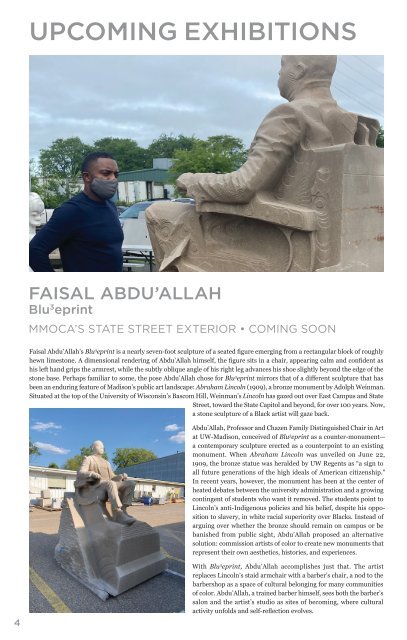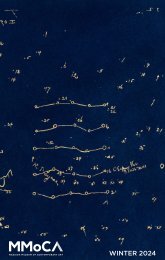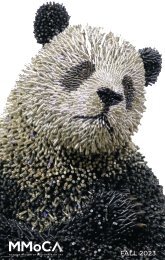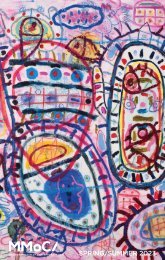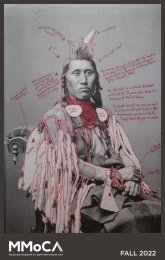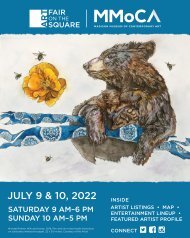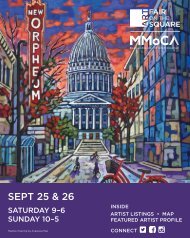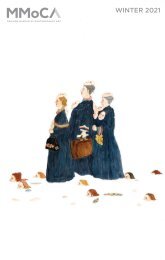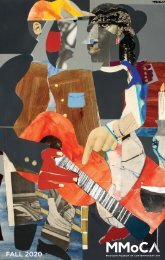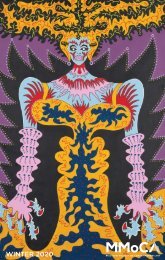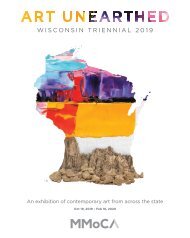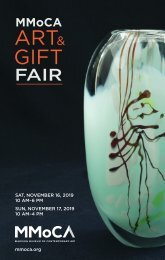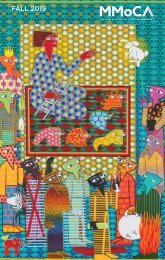Fall 2021 Madison Museum of Contemporary Art (MMoCA) Newsletter
Exhibitions, activities, education programming and more!
Exhibitions, activities, education programming and more!
Create successful ePaper yourself
Turn your PDF publications into a flip-book with our unique Google optimized e-Paper software.
UPCOMING EXHIBITIONS<br />
FAISAL ABDU’ALLAH<br />
Blu 3 eprint<br />
MMOCA’S STATE STREET EXTERIOR • COMING SOON<br />
Faisal Abdu’Allah’s Blu 3 eprint is a nearly seven-foot sculpture <strong>of</strong> a seated figure emerging from a rectangular block <strong>of</strong> roughly<br />
hewn limestone. A dimensional rendering <strong>of</strong> Abdu’Allah himself, the figure sits in a chair, appearing calm and confident as<br />
his left hand grips the armrest, while the subtly oblique angle <strong>of</strong> his right leg advances his shoe slightly beyond the edge <strong>of</strong> the<br />
stone base. Perhaps familiar to some, the pose Abdu’Allah chose for Blu 3 eprint mirrors that <strong>of</strong> a different sculpture that has<br />
been an enduring feature <strong>of</strong> <strong>Madison</strong>’s public art landscape: Abraham Lincoln (1909), a bronze monument by Adolph Weinman.<br />
Situated at the top <strong>of</strong> the University <strong>of</strong> Wisconsin’s Bascom Hill, Weinman’s Lincoln has gazed out over East Campus and State<br />
Street, toward the State Capitol and beyond, for over 100 years. Now,<br />
a stone sculpture <strong>of</strong> a Black artist will gaze back.<br />
Abdu’Allah, Pr<strong>of</strong>essor and Chazen Family Distinguished Chair in <strong>Art</strong><br />
at UW-<strong>Madison</strong>, conceived <strong>of</strong> Blu 3 eprint as a counter-monument—<br />
a contemporary sculpture erected as a counterpoint to an existing<br />
monument. When Abraham Lincoln was unveiled on June 22,<br />
1909, the bronze statue was heralded by UW Regents as “a sign to<br />
all future generations <strong>of</strong> the high ideals <strong>of</strong> American citizenship.”<br />
In recent years, however, the monument has been at the center <strong>of</strong><br />
heated debates between the university administration and a growing<br />
contingent <strong>of</strong> students who want it removed. The students point to<br />
Lincoln’s anti-Indigenous policies and his belief, despite his opposition<br />
to slavery, in white racial superiority over Blacks. Instead <strong>of</strong><br />
arguing over whether the bronze should remain on campus or be<br />
banished from public sight, Abdu’Allah proposed an alternative<br />
solution: commission artists <strong>of</strong> color to create new monuments that<br />
represent their own aesthetics, histories, and experiences.<br />
4<br />
With Blu 3 eprint, Abdu’Allah accomplishes just that. The artist<br />
replaces Lincoln’s staid armchair with a barber’s chair, a nod to the<br />
barbershop as a space <strong>of</strong> cultural belonging for many communities<br />
<strong>of</strong> color. Abdu’Allah, a trained barber himself, sees both the barber’s<br />
salon and the artist’s studio as sites <strong>of</strong> becoming, where cultural<br />
activity unfolds and self-reflection evolves.


